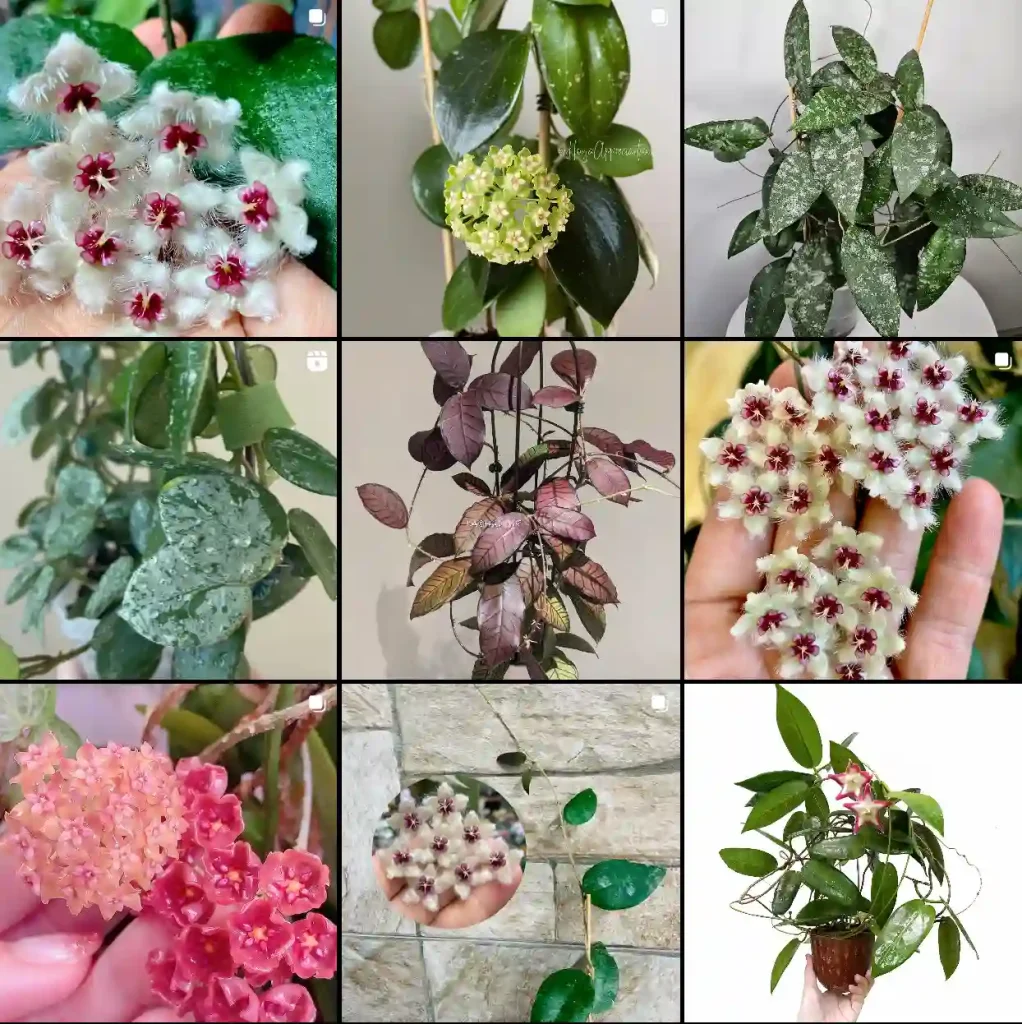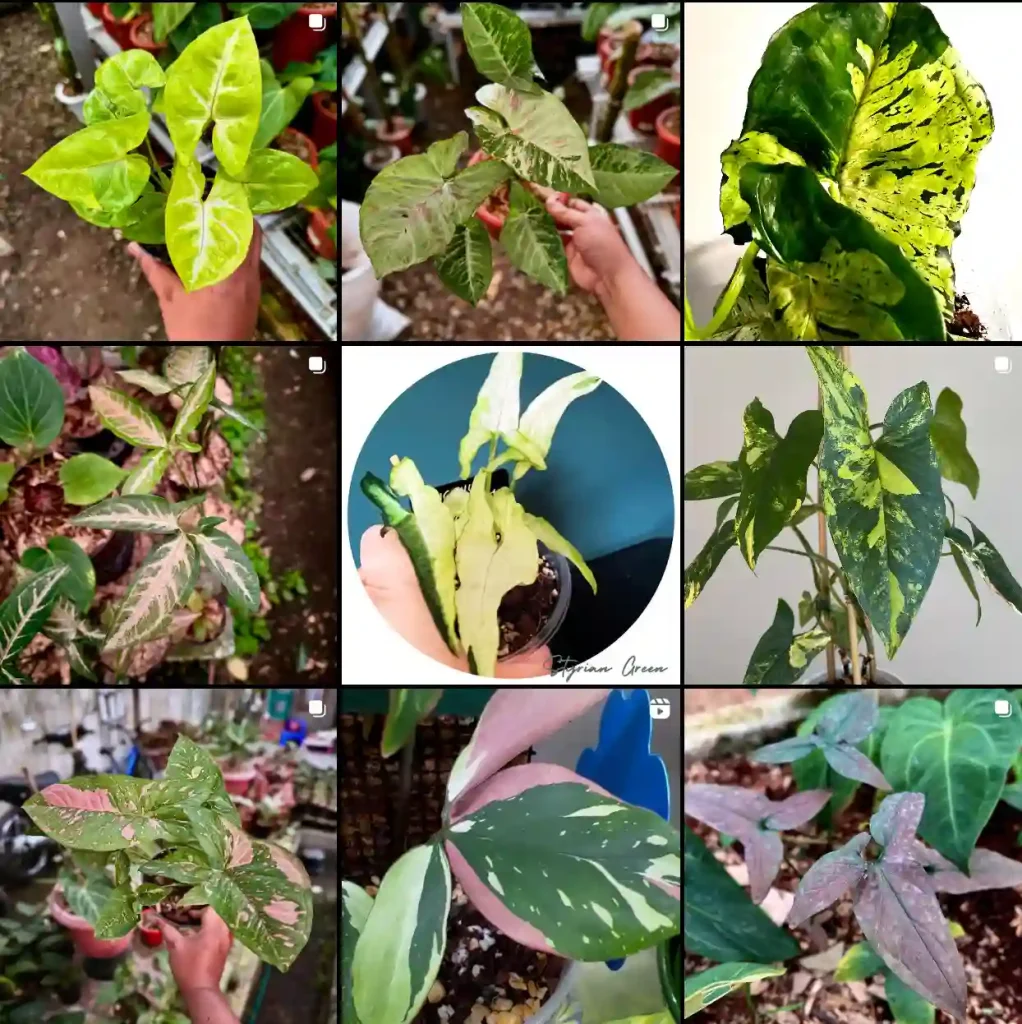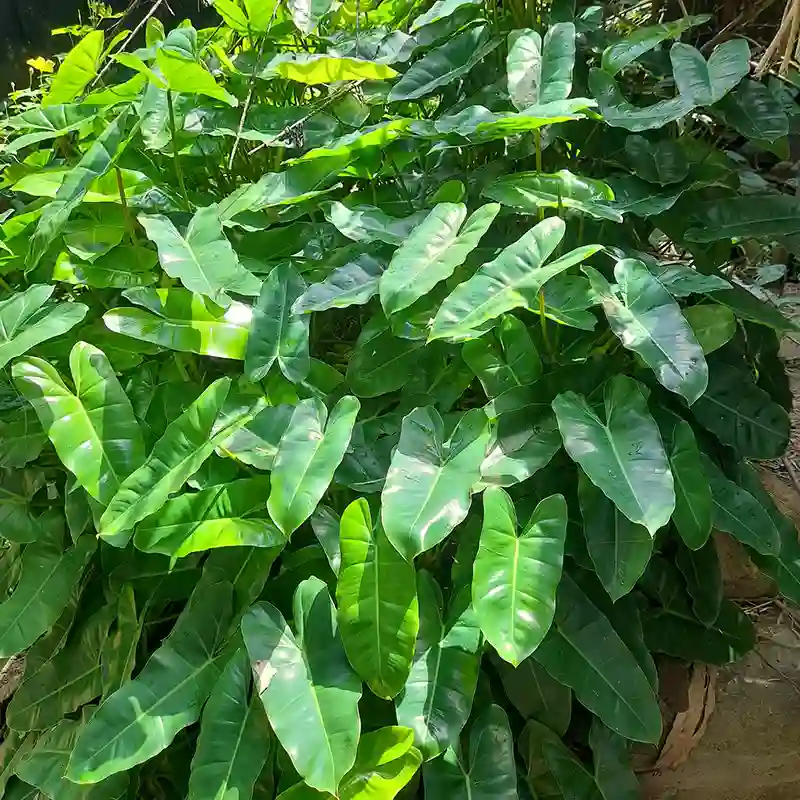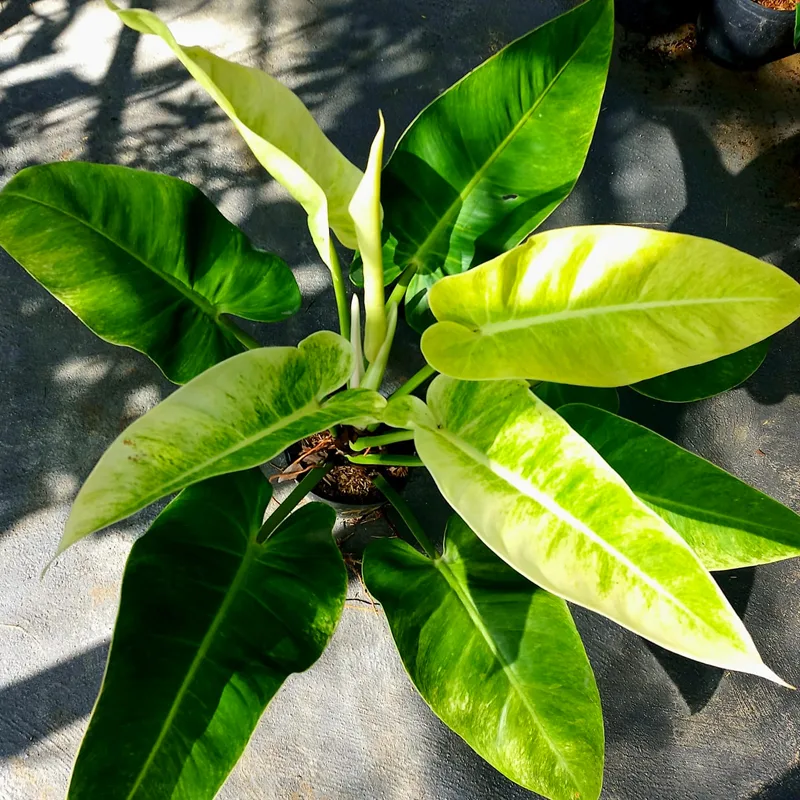My Love Affair with Philodendrons
Hi, I’m Ferb Vu, and I’ve got a confession to make: I’m utterly smitten with philodendrons. These plants, with their incredible diversity and relatively low-maintenance requirements, have completely captured my heart (and a significant portion of my living space). I’m constantly amazed by their varied forms, from the classic heart-shaped leaves of the Philodendron hederaceum to the deeply lobed, almost skeletal foliage of the Philodendron bipennifolium.
There’s just something about the way a philodendron can transform a room. They bring a touch of the exotic, a sense of the jungle, to any space they inhabit. And for someone like me, who craves a connection with nature even when indoors, they’re the perfect companions.
Why Philodendrons?
What is it about these plants that draws me in? Well, for starters, they’re incredibly versatile. Whether you’re looking for a trailing vine to cascade from a shelf, a compact plant to brighten a desk, or a statement piece to anchor a corner, there’s a philodendron out there for you. They come in a dazzling array of colors, from deep greens to vibrant reds and even almost black. Some varieties, like the Philodendron birkin, sport striking variegation, with splashes of white or yellow adding to their visual appeal.
But their beauty is more than just skin deep. Philodendrons are also remarkably resilient. They can tolerate a wide range of conditions, making them ideal for plant enthusiasts of all skill levels. Even someone with a less-than-green thumb (like myself, in the beginning) can successfully cultivate these beauties.
A Diverse Genus
The genus Philodendron is vast, encompassing hundreds of species. Here are:
- Philodendron acreanum K.Krause
- Philodendron acuminatissimum Engl.
- Philodendron acutifolium K.Krause
- Philodendron adamantinum Mart. ex Schott
- Philodendron adhatodifolium Schott
- Philodendron advena Schott
- Philodendron aemulum Schott
- Philodendron agudeloi Croat, Edwin Trujillo & Mines
- Philodendron alanbrantii Croat
- Philodendron alatisulcatum Croat
- Philodendron alatiundulatum Croat
- Philodendron alatum Poepp.
- Philodendron albisuccus Croat
- Philodendron alliodorum Croat & Grayum
- Philodendron alonsoae Croat
- Philodendron alternans Schott
- Philodendron alticola Croat & Grayum
- Philodendron altomacaense Nadruz & Mayo
- Philodendron amargalense Croat & M.M.Mora
- Philodendron ampamii Croat
- Philodendron amplisinum G.S.Bunting
- Philodendron ampullaceum G.S.Bunting
- Philodendron anaadu G.S.Bunting
- Philodendron ancuashii Croat
- Philodendron angosturense Croat
- Philodendron angustialatum Engl.
- Philodendron angustilobum Croat & Grayum
- Philodendron angustisectum Engl.
- Philodendron anisotomum Schott
- Philodendron annulatum Croat
- Philodendron anthracyne Croat
- Philodendron antonioanum Croat
- Philodendron apiculatum Croat & M.M.Mora
- Philodendron appendiculatum Nadruz & Mayo
- Philodendron applanatum G.M.Barroso
- Philodendron appunii G.S.Bunting
- Philodendron arbelaezii Croat & F.Cardona
- Philodendron arevaloi Croat
- Philodendron aristeguietae G.S.Bunting
- Philodendron aromaticum Croat & Grayum
- Philodendron asplundii Croat & M.L.Soares
- Philodendron atabapoense G.S.Bunting
- Philodendron atratum Croat
- Philodendron attenuatum Croat
- Philodendron aurantiifolium Schott
- Philodendron aurantiispadix Croat
- Philodendron aureimarginatum Croat
- Philodendron auriculatum Standl. & L.O.Williams
- Philodendron auritum Lindl.
- Philodendron auyantepuiense G.S.Bunting
- Philodendron avenium Grayum & Croat
- Philodendron ayalae Croat
- Philodendron ayangannense Croat
- Philodendron azulitense Croat
- Philodendron bahiense Engl.
- Philodendron bakeri Croat & Grayum
- Philodendron balaoanum Engl.
- Philodendron barbourii Croat
- Philodendron barrosoanum G.S.Bunting
- Philodendron basii Matuda
- Philodendron basivaginatum K.Krause
- Philodendron baudoense Croat & D.C.Bay
- Philodendron bayae Croat
- Philodendron beniteziae Croat
- Philodendron bernardoi Croat
- Philodendron bernardopazii E.G.Gonç.
- Philodendron bethoweniae Croat
- Philodendron bicolor Croat, Scherber., M.M.Mora & G.Ferry
- Philodendron billietiae Croat
- Philodendron bipennifolium Schott
- Philodendron bipinnatifidum Schott ex Endl.
- Philodendron biribiriense Sakur. & Mayo
- Philodendron blanchetianum Schott
- Philodendron bogotense Engl.
- Philodendron bomboizense Croat & Cerón
- Philodendron bonifaziae Croat
- Philodendron borgesii G.S.Bunting
- Philodendron brandii Grayum
- Philodendron brandtianum K.Krause
- Philodendron brantii Croat
- Philodendron brasiliense Engl.
- Philodendron breedlovei Croat
- Philodendron brenesii Standl.
- Philodendron brent-berlinii Croat
- Philodendron brevispathum Schott
- Philodendron brewsterense Croat
- Philodendron brunneicaule Croat & Grayum
- Philodendron bucayense Croat
- Philodendron buntingianum Croat
- Philodendron burgeri Grayum
- Philodendron burle-marxii G.M.Barroso
- Philodendron calatheifolium G.S.Bunting
- Philodendron callosum K.Krause
- Philodendron camarae Croat
- Philodendron campii Croat
- Philodendron camposportoanum G.M.Barroso
- Philodendron canaimae G.S.Bunting
- Philodendron candamoense Croat
- Philodendron canicaule Croat & D.C.Bay
- Philodendron caracaraiense Croat
- Philodendron carajasense E.G.Gonç. & A.J.Arruda
- Philodendron caranoense Croat, Edwin Trujillo & Marco Correa
- Philodendron cardonii Croat
- Philodendron cardosoi E.G.Gonç.
- Philodendron carinatum E.G.Gonç.
- Philodendron cataniapoense G.S.Bunting
- Philodendron caudatum K.Krause
- Philodendron cerrojefense M.M.Mora & Croat
- Philodendron chanchamayense Engl.
- Philodendron chepiganense O.Ortiz, Croat & Rodr.-Reyes
- Philodendron chimantae G.S.Bunting
- Philodendron chimboanum Engl.
- Philodendron chiriquense Croat
- Philodendron chirripoense Croat & Grayum
- Philodendron chrysocarpum Croat & D.C.Bay
- Philodendron cipoense Sakur. & Mayo
- Philodendron clarkei Croat
- Philodendron clewellii Croat
- Philodendron coibense Croat & O.Ortiz
- Philodendron colombianum R.E.Schult.
- Philodendron coloradense Croat
- Philodendron condorcanquense Croat
- Philodendron conforme G.S.Bunting
- Philodendron consanguineum Schott
- Philodendron consobrinum G.S.Bunting
- Philodendron copense Croat
- Philodendron corcovadense Kunth
- Philodendron cordatum Kunth ex Schott
- Philodendron coriaceum Croat & D.C.Bay
- Philodendron correae Croat
- Philodendron cotapatense Croat & Acebey
- Philodendron cotobrusense Croat & Grayum
- Philodendron cotonense Croat & Grayum
- Philodendron craspedodromum R.E.Schult.
- Philodendron crassinervium Lindl.
- Philodendron crassispathum Croat & Grayum
- Philodendron crassum Rendle
- Philodendron cremersii Croat & Grayum
- Philodendron cretosum Croat & Grayum
- Philodendron croatii Grayum
- Philodendron cruentospathum Madison
- Philodendron cruentum Poepp.
- Philodendron crystallum Croat & Edwin Trujillo
- Philodendron cuangosense Croat
- Philodendron cuneatum Engl.
- Philodendron curvilobum Schott
- Philodendron curvipetiolatum Croat
- Philodendron dalyi Croat
- Philodendron daniellii Croat & Oberle
- Philodendron danteanum G.S.Bunting
- Philodendron dardanianum Mayo
- Philodendron darienense O.Ortiz, Croat & Rodr.-Reyes
- Philodendron davidneillii Croat
- Philodendron davidsei G.S.Bunting
- Philodendron davidsonii Croat
- Philodendron deflexum Poepp. ex Schott
- Philodendron delannayi Croat
- Philodendron delascioi G.S.Bunting
- Philodendron delgadoae Croat & Delannay
- Philodendron delinksii Croat & Köster
- Philodendron deltoideum Poepp.
- Philodendron densivenium Engl.
- Philodendron devansayeanum André
- Philodendron devianum Croat
- Philodendron dioscoreoides Gleason
- Philodendron discretivenium Croat & D.C.Bay
- Philodendron distantilobum K.Krause
- Philodendron divaricatum K.Krause
- Philodendron dodsonii Croat & Grayum
- Philodendron dolichophyllum Croat
- Philodendron dominicalense Croat & Grayum
- Philodendron dressleri G.S.Bunting
- Philodendron dryanderae Croat & D.C.Bay
- Philodendron duckei Croat & Grayum
- Philodendron dunstervilleorum G.S.Bunting
- Philodendron dussii Engl.
- Philodendron dwyeri Croat
- Philodendron dyscarpium R.E.Schult.
- Philodendron eburneum K.Krause
- Philodendron ecordatum Schott
- Philodendron edenudatum Croat
- Philodendron edmundoi G.M.Barroso
- Philodendron edwinii Croat & Marco Correa
- Philodendron effusilobum Croat
- Philodendron elaphoglossoides Schott
- Philodendron elegans K.Krause
- Philodendron elegantulum Croat & Grayum
- Philodendron englerianum Steyerm.
- Philodendron ensifolium Croat & Grayum
- Philodendron ernestii Engl.
- Philodendron erubescens K.Koch & Augustin
- Philodendron escuintlense Matuda
- Philodendron esmeraldense Croat
- Philodendron exile G.S.Bunting
- Philodendron eximium Schott
- Philodendron fasciculatum Croat
- Philodendron fendleri K.Krause
- Philodendron ferrugineum Croat
- Philodendron fibraecataphyllum M.M.Mora & Croat
- Philodendron fibrillosum Poepp.
- Philodendron fibrosum Sodiro ex Croat
- Philodendron findens Croat & Grayum
- Philodendron florianetlii Croat & Grayum
- Philodendron flumineum E.G.Gonç.
- Philodendron follii Nadruz
- Philodendron folsomii Croat
- Philodendron fortunense Croat
- Philodendron fosteri Croat
- Philodendron fragile Nadruz & Mayo
- Philodendron fragrantissimum (Hook.) G.Don
- Philodendron fraternum Schott
- Philodendron furcatum Croat & D.C.Bay
- Philodendron galotipazii Croat
- Philodendron gardeniodorum Croat, D.P.Hannon & Delannay
- Philodendron genevieveanum Croat
- Philodendron geniculatum Bogner & Croat
- Philodendron gentryi Croat
- Philodendron giganteum Schott
- Philodendron gigas Croat
- Philodendron glanduliferum Matuda
- Philodendron glaziovii Hook.f.
- Philodendron gloriosum André
- Philodendron goeldii G.M.Barroso
- Philodendron gonzalezii Grayum
- Philodendron grahamii Croat
- Philodendron grandifolium (Jacq.) Schott
- Philodendron grandipes K.Krause
- Philodendron granulare Croat
- Philodendron graveolens Engl.
- Philodendron grayumii Croat
- Philodendron grazielae G.S.Bunting
- Philodendron grenandii Croat
- Philodendron gribianum Croat
- Philodendron guadalupense Croat
- Philodendron guadarramanum Diaz Jim., Croat & Aguilar-Rodr.
- Philodendron guaiquinimae G.S.Bunting
- Philodendron gualeanum Engl.
- Philodendron guasagandense Croat
- Philodendron guianense Croat & Grayum
- Philodendron guizaense Croat
- Philodendron guttiferum Kunth
- Philodendron hammelii Croat
- Philodendron hannoniae Croat
- Philodendron hastatum K.Koch & Sello
- Philodendron hatschbachii Nadruz & Mayo
- Philodendron hebetatum Croat
- Philodendron hederaceum (Jacq.) Schott
- Philodendron heleniae Croat
- Philodendron henry-pittieri G.S.Bunting
- Philodendron herbaceum Croat & Grayum
- Philodendron herthae K.Krause
- Philodendron heterocraspedon Croat & D.C.Bay
- Philodendron heterophyllum Poepp.
- Philodendron heteropleurum K.Krause
- Philodendron holstii G.S.Bunting
- Philodendron holtonianum Schott
- Philodendron hooveri Croat & Grayum
- Philodendron hopkinsianum M.L.Soares & Mayo
- Philodendron houlletianum Engl.
- Philodendron huanucense Engl.
- Philodendron huashikatii Croat
- Philodendron huaynacapacense Croat
- Philodendron hughclarkei Croat
- Philodendron humile E.G.Gonç.
- Philodendron hyalinum Croat
- Philodendron hylaeae G.S.Bunting
- Philodendron ichthyoderma Croat & Grayum
- Philodendron immixtum Croat
- Philodendron inaequilaterum Liebm.
- Philodendron inconcinnum Schott
- Philodendron inops Schott
- Philodendron insigne Schott
- Philodendron ishichimiense Croat
- Philodendron jacquinii Schott
- Philodendron jefense Croat
- Philodendron jimenae Croat
- Philodendron joaosilvae Croat, A.Cardoso & Moonen
- Philodendron jodavisianum G.S.Bunting
- Philodendron × joepii Croat
- Philodendron jonkerorum Croat
- Philodendron josefinense Croat
- Philodendron josephii C.A.S.Bat. & M.L.Soares
- Philodendron juninense Engl.
- Philodendron kaieteurense Croat
- Philodendron kautskyi G.S.Bunting
- Philodendron killipii K.Krause
- Philodendron knappiae Croat
- Philodendron krauseanum Steyerm.
- Philodendron kressii Croat
- Philodendron kroemeri Croat
- Philodendron krugii Engl.
- Philodendron lacerum (Jacq.) Schott
- Philodendron laticiferum Croat & M.M.Mora
- Philodendron latifolium K.Koch
- Philodendron lazorii Croat
- Philodendron leal-costae Mayo & G.M.Barroso
- Philodendron lechlerianum Schott
- Philodendron lehmannii Engl.
- Philodendron lemae G.S.Bunting
- Philodendron lemorae Croat
- Philodendron lentii Croat & Grayum
- Philodendron leucanthum K.Krause
- Philodendron leyvae García-Barr.
- Philodendron liesneri G.S.Bunting
- Philodendron ligulatum Schott
- Philodendron lindenianum Wallis
- Philodendron lindenii Schott
- Philodendron linganii Croat
- Philodendron linguifolium Schott
- Philodendron lingulatum (L.) K.Koch
- Philodendron linnaei Kunth
- Philodendron llanense Croat
- Philodendron loefgrenii Engl.
- Philodendron longilaminatum Schott
- Philodendron longilobatum Sakur.
- Philodendron longilobum M.M.Mora & Croat
- Philodendron longipedunculatum Croat & M.M.Mora
- Philodendron longipes Engl.
- Philodendron longirrhizum M.M.Mora & Croat
- Philodendron longistilum K.Krause
- Philodendron × lucasiorum Croat & Moonen
- Philodendron luisae Calazans
- Philodendron lundii Warm.
- Philodendron lupinum E.G.Gonç. & J.B.Carvalho
- Philodendron luteonervium Croat
- Philodendron luxurians Croat, D.P.Hannon & R.Kaufmann
- Philodendron lynnhannoniae Croat
- Philodendron macarenense Croat
- Philodendron macroglossum Schott
- Philodendron macropodum K.Krause
- Philodendron maculatum K.Krause
- Philodendron madalenense J.Mattos, Nadruz & Baumgratz
- Philodendron madronense Croat
- Philodendron magnum Croat
- Philodendron maguirei G.S.Bunting
- Philodendron malesevichiae Croat
- Philodendron mamei André
- Philodendron mansellii Croat
- Philodendron manuelii Croat
- Philodendron marahuacae G.S.Bunting
- Philodendron marcarlsoniae Croat
- Philodendron marcocorreanum Croat, M.M.Mora & Edwin Trujillo
- Philodendron maroae G.S.Bunting
- Philodendron martianum Engl.
- Philodendron martinezii Croat & O.Ortiz
- Philodendron martini Schott
- Philodendron mashpiense Croat
- Philodendron mathewsii Schott
- Philodendron mawarinumae G.S.Bunting
- Philodendron maximum K.Krause
- Philodendron mayoi E.G.Gonç.
- Philodendron mazorcalense Croat
- Philodendron mcphersonii Croat
- Philodendron megalophyllum Schott
- Philodendron meieri Croat
- Philodendron melanochrysum Linden & André
- Philodendron melanoneuron Croat
- Philodendron melanum Croat
- Philodendron melinonii Brongn. ex Regel
- Philodendron mello-barretoanum Burle-Marx ex G.M.Barroso
- Philodendron melloi Irume & M.L.Soares
- Philodendron membranaceum Poepp.
- Philodendron mendozae Croat
- Philodendron mentiens Croat & Delannay
- Philodendron meraense Croat
- Philodendron merenbergense Croat
- Philodendron meridense G.S.Bunting
- Philodendron meridionale Buturi & Sakur.
- Philodendron merizaldense Croat
- Philodendron mesae G.S.Bunting
- Philodendron mesayense Croat
- Philodendron mexicanum Engl.
- Philodendron micranthum Poepp. ex Schott
- Philodendron microstictum Standl. & L.O.Williams
- Philodendron millerianum Nadruz & Sakur.
- Philodendron minarum Engl.
- Philodendron minesianum Croat
- Philodendron misahualliense Croat & Cerón
- Philodendron missionum (Hauman) Hauman
- Philodendron modestum Schott
- Philodendron monroi Croat & O.Ortiz
- Philodendron monsalveae Croat & D.C.Bay
- Philodendron montanum Engl.
- Philodendron monteagudoi Croat
- Philodendron montemariense Croat, J.J.Percy & Carrascal
- Philodendron moonenii Croat
- Philodendron morii Croat
- Philodendron multinervum G.S.Bunting
- Philodendron multispadiceum Engl.
- Philodendron muricatum Schott
- Philodendron musifolium Engl.
- Philodendron myrmecophilum Engl.
- Philodendron nadruzianum Sakur.
- Philodendron nanegalense Engl.
- Philodendron nangaritense Croat
- Philodendron narinoense Croat
- Philodendron narvaezii Croat
- Philodendron nebulense G.S.Bunting
- Philodendron nelsonzamorae Croat & Grayum
- Philodendron nievense Croat
- Philodendron nigrifactum Croat
- Philodendron ninoanum Croat & D.C.Bay
- Philodendron niqueanum Croat
- Philodendron nullinervium E.G.Gonç.
- Philodendron oblanceolatum Croat & D.C.Bay
- Philodendron obliquifolium Engl.
- Philodendron oblongum (Vell.) Kunth
- Philodendron obtusilobum Miq.
- Philodendron ochrostemon Schott
- Philodendron oligospermum Engl.
- Philodendron opacum Croat & Grayum
- Philodendron orionis G.S.Bunting
- Philodendron ornatum Schott
- Philodendron ovatoluteum Croat
- Philodendron oxycataphyllum Croat
- Philodendron pachycaule K.Krause
- Philodendron pachyphyllum K.Krause
- Philodendron palaciosii Croat & Grayum
- Philodendron palmicola Croat
- Philodendron paloraense Croat
- Philodendron paludicola E.G.Gonç. & Salviani
- Philodendron pambilarense Croat
- Philodendron panamense K.Krause
- Philodendron panduriforme (Kunth) Kunth
- Philodendron parvidactylum Croat
- Philodendron parvilobum Croat
- Philodendron pastazanum K.Krause
- Philodendron patriciae Croat
- Philodendron paucinervium Croat
- Philodendron paxianum K.Krause
- Philodendron pedatum (Hook.) Kunth
- Philodendron pedunculum Croat & Grayum
- Philodendron peperomioides G.S.Bunting
- Philodendron peraiense G.S.Bunting
- Philodendron perplexum G.S.Bunting
- Philodendron petraeum Chodat & Vischer
- Philodendron phlebodes G.S.Bunting
- Philodendron picoranense Croat
- Philodendron pierrelianum Scherber., Croat, M.M.Mora & G.Ferry
- Philodendron pimichinese G.S.Bunting
- Philodendron pinnatifidum (Jacq.) Schott
- Philodendron pinnatilobum Engl.
- Philodendron pipolyi Croat
- Philodendron pirrense Croat
- Philodendron placidum Schott
- Philodendron planadense Croat
- Philodendron platypetiolatum Madison
- Philodendron platypodum Gleason
- Philodendron pogonocaule Madison
- Philodendron pokigronense Croat
- Philodendron polliciforme Croat & D.C.Bay
- Philodendron popenoei Standl. & Steyerm.
- Philodendron populneum K.Koch ex Schott
- Philodendron prancei Croat
- Philodendron profundisulcatum Croat
- Philodendron prominulinervium Croat
- Philodendron propinquum Schott
- Philodendron pseudauriculatum Croat
- Philodendron pseudoundulatum Grau
- Philodendron pseudoverrucosum Croat
- Philodendron pteropus Mart. ex Engl.
- Philodendron pterotum K.Koch & Augustin
- Philodendron puhuangii Croat
- Philodendron pulchellum Engl.
- Philodendron pulchrum G.M.Barroso
- Philodendron purpureoviride Engl.
- Philodendron purulhense Croat
- Philodendron pusillum E.G.Gonç. & Bogner
- Philodendron quelalii Croat & Mines
- Philodendron quinquelobum K.Krause
- Philodendron quinquenervium Miq.
- Philodendron quitense Engl.
- Philodendron radiatum Schott
- Philodendron rayanum Croat & Grayum
- Philodendron recurvifolium Schott
- Philodendron remifolium R.E.Schult.
- Philodendron renauxii Reitz
- Philodendron reticulatum Grayum
- Philodendron rex A.Hay
- Philodendron rheophyticum Buturi & Temponi
- Philodendron rhizomatosum Sakur. & Mayo
- Philodendron rhodoaxis G.S.Bunting
- Philodendron rhodospathiphyllum Croat & D.C.Bay
- Philodendron rhodospermum Calazans & Sakur.
- Philodendron ricardoi E.G.Gonç.
- Philodendron ricaurtense Croat
- Philodendron rigidifolium K.Krause
- Philodendron rimachii Croat
- Philodendron rio-pretense C.A.S.Bat. & M.L.Soares
- Philodendron riparium Engl.
- Philodendron robustum Schott
- Philodendron rocioae Grayum
- Philodendron rodrigueziae Croat & Grayum
- Philodendron roezlii W.Bull
- Philodendron rojasianum Standl. & Steyerm.
- Philodendron romeroi Grayum
- Philodendron roraimae K.Krause
- Philodendron roseocataphyllum Croat & M.M.Mora
- Philodendron roseopetiolatum Nadruz & Mayo
- Philodendron roseospathum Croat
- Philodendron rubioi Croat
- Philodendron rubrijuvenile Croat & R.Kaufmann
- Philodendron rubrocinctum Engl.
- Philodendron rubromaculatum Croat & D.C.Bay
- Philodendron rudgeanum Schott
- Philodendron rugapetiolatum Croat & M.M.Mora
- Philodendron rugosum Bogner & G.S.Bunting
- Philodendron ruizii Schott
- Philodendron ruthianum Nadruz
- Philodendron sabaletense Croat
- Philodendron sagittifolium Liebm.
- Philodendron samayense G.S.Bunting
- Philodendron samudioense Croat & O.Ortiz
- Philodendron sanmarcoense Croat
- Philodendron santodominguense G.S.Bunting
- Philodendron saxicola K.Krause
- Philodendron scalarinerve Croat & Grayum
- Philodendron scherberichii Croat & M.M.Mora
- Philodendron schmidtiae Croat & Cerón
- Philodendron schottianum H.Wendl. ex Schott
- Philodendron schottii K.Koch
- Philodendron scitulum G.S.Bunting
- Philodendron scottmorianum Croat & Moonen
- Philodendron seguine Schott
- Philodendron senatocarpium Madison
- Philodendron serpens Hook.f.
- Philodendron sharoniae Croat
- Philodendron silverstonei Croat
- Philodendron simmondsii Mayo
- Philodendron simonianum Sakur.
- Philodendron simsii (Hook.) Sweet ex Kunth
- Philodendron simulans G.S.Bunting
- Philodendron smithii Engl.
- Philodendron sodiroi N.E.Br.
- Philodendron solimoesense A.C.Sm.
- Philodendron sonderianum Schott
- Philodendron sousae Croat
- Philodendron sparreorum Croat
- Philodendron speciosum Schott ex Endl.
- Philodendron sphalerum Schott
- Philodendron spiritus-sancti G.S.Bunting
- Philodendron splitgerberi Schott
- Philodendron spruceanum G.S.Bunting
- Philodendron squamicaule Croat & Grayum
- Philodendron squamiferum Poepp.
- Philodendron squamipetiolatum Croat
- Philodendron standleyi Grayum
- Philodendron stenolobum E.G.Gonç.
- Philodendron stenophyllum K.Krause
- Philodendron steyermarkii G.S.Bunting
- Philodendron straminicaule Croat
- Philodendron striatum Croat & D.C.Bay
- Philodendron strictum G.S.Bunting
- Philodendron suberosum Croat & D.C.Bay
- Philodendron subhastatum K.Krause
- Philodendron subincisum Schott
- Philodendron sucrense G.S.Bunting
- Philodendron sulcatum K.Krause
- Philodendron sulcicaule Croat
- Philodendron surinamense (Miq.) Engl.
- Philodendron swartiae Croat
- Philodendron tachirense G.S.Bunting
- Philodendron tarmense Engl.
- Philodendron tatei K.Krause
- Philodendron tenue K.Koch & Augustin
- Philodendron tenuipes Engl.
- Philodendron tenuispadix E.G.Gonç.
- Philodendron teretipes Sprague
- Philodendron thalassicum Croat & Grayum
- Philodendron thaliifolium Schott
- Philodendron theofiloanum Calazans
- Philodendron tortum M.L.Soares & Mayo
- Philodendron toshibae M.L.Soares & Mayo
- Philodendron traunii Engl.
- Philodendron triangulare G.S.Bunting
- Philodendron tricostatum Croat & D.C.Bay
- Philodendron tripartitum (Jacq.) Schott
- Philodendron triplum G.S.Bunting
- Philodendron trisectifolium Croat
- Philodendron trojitense Croat & D.C.Bay
- Philodendron trujilloi G.S.Bunting
- Philodendron tuerckheimii Grayum
- Philodendron tweedieanum Schott
- Philodendron tysonii Croat
- Philodendron ubigantupense Croat
- Philodendron uleanum Engl.
- Philodendron uliginosum Mayo
- Philodendron undulatum Engl.
- Philodendron urraoense Croat
- Philodendron ushanum Croat & Moonen
- Philodendron utleyanum Croat
- Philodendron validinervium Engl.
- Philodendron vargealtense Sakur.
- Philodendron variifolium Schott
- Philodendron venezuelense G.S.Bunting
- Philodendron venosum (Willd. ex Schult. & Schult.f.) Croat
- Philodendron ventricosum Madison
- Philodendron venulosum Croat & D.C.Bay
- Philodendron venustifoliatum E.G.Gonç. & Mayo
- Philodendron venustum G.S.Bunting
- Philodendron verapazense Croat
- Philodendron verrucapetiolum Croat
- Philodendron verrucosum L.Mathieu ex Schott
- Philodendron victoriae G.S.Bunting
- Philodendron vinaceum G.S.Bunting
- Philodendron viride Engl.
- Philodendron wadedavisii Croat
- Philodendron wallisii Regel ex Engl.
- Philodendron warszewiczii K.Koch & C.D.Bouché
- Philodendron weberbaueri Engl.
- Philodendron wendlandii Schott
- Philodendron werkhoveniae Croat
- Philodendron werneri Croat
- Philodendron wilburii Croat & Grayum
- Philodendron williamsii Hook.f.
- Philodendron wittianum Engl.
- Philodendron woronowii K.Krause
- Philodendron wullschlaegelii Schott
- Philodendron wurdackii G.S.Bunting
- Philodendron xanadu Croat, Mayo & J.Boos
- Philodendron yavitense G.S.Bunting
- Philodendron yutajense G.S.Bunting
- Philodendron zhuanum Croat
Caring for Your Philodendron
While philodendrons are generally low-maintenance, they do have a few basic needs. Here are some tips to keep your philodendron happy and thriving:
- Light: Most philodendrons prefer bright, indirect light. Avoid placing them in direct sunlight, which can scorch their leaves.
- Water: Allow the soil to dry out slightly between waterings. Overwatering can lead to root rot, which is a common problem for philodendrons.
- Humidity: Philodendrons appreciate higher humidity levels, especially those with thinner leaves. You can increase humidity by misting the plant regularly or placing it on a pebble tray filled with water.
- Soil: A well-draining potting mix is essential. You can add perlite or orchid bark to improve drainage.
- Support: Many philodendrons are climbers and will benefit from a moss pole or other support to climb on.
By following these simple guidelines, you can ensure that your philodendron thrives and brings you years of enjoyment.
More Than Just a Plant
For me, philodendrons are more than just decorative objects. They’re living beings that bring life and vibrancy to my home. Caring for them provides a sense of purpose and connection to the natural world. I love watching them grow and change, putting out new leaves and reaching for the sky.
If you’re looking to add a touch of greenery to your life, I highly recommend considering a philodendron. With their beauty, resilience, and diversity, they’re sure to capture your heart just as they’ve captured mine.




